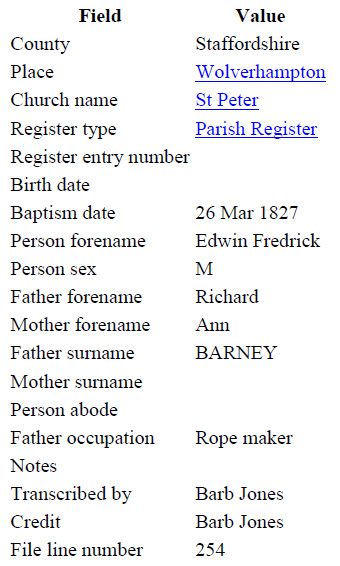
Source: https://www.freereg.org.uk
Edwin Frederick Barney
Edwin Frederick Barney was born in Wolverhampton, Staffordshire in 1827 and was Christened at St. Peter's Collegiate Church, Wolverhampton on March 26, 1827.

Source: https://www.freereg.org.uk
Sources (cited below) indicate that Edwin
worked variously as a Painter, Glazier, Plumber, 'House Painter & Paper Hanger' Journeyman, and spent most of
his young life in Wolverhampton, Staffordshire.
The marriage certificate of Edwin's son, Sydney
Frederick 'Barnett'* (1880) indicates that Edwin
had worked as
a 'Japanner'. 'Japanned ware' was popular among the
middle-classes in the early-middle 1800's and the Japanning industry thrived in
Wolverhampton.
More info here:
http://www.historywebsite.co.uk/Museum/metalware/japintro.htm and here:
http://www.wolverhamptonhistory.org.uk/work/industry/japanning
*
Speculation on a possible reason for the generational
name change from 'Barney' to 'Barnett' is discussed at the bottom of this page.
|
Ellen Flynn - Edwin's future wife
Ellen was born in Tipperary, Ireland in January 1833 and was Baptised in the Roman Catholic Diocese of Cashel and Emly on January 27, 1833. Source: https://search.ancestry.com/cgi-bin/sse.dll?indiv=try&h=5053031&dbid=61039 National Library of Ireland; Dublin, Ireland; Microfilm Number: Microfilm 02508 / 01 Name: Ellen Flynn Baptism Age: 0 Event Type: Baptism Birth Date: 1833 Baptism Date: 27 Jan 1833 Baptism Place: Murroe, Boher and Abington, Limerick and Tipperary, Ireland Parish Variants: Abington, Boher, Murroe, Murroe and Boher Diocese: Cashel and Emly Father: James Flynn Mother: Mary Fleming Research, presented in a 2018 edition of 'Who Do You Think You Are' (the subject; USA Singer/Actress Mandy Moore, a descendent of Edwin & Ellen Barney) found that Ellen lived with her mother and her sister Mary, in the Cashel Workhouse, Tipperary. The father had deserted the family (immigrating to America) and Ellen's mother died (aged 40) on April 14, 1848. Ellen and her sister, effectively orphans, faced with life confined to the workhouse in the midst of the Great Irish Famine, headed for a new life in Australia entering into 'indentured servitude'* under the 'Earl Grey Famine Orphan Scheme'. They sailed on the ship 'Lady Peel' arriving in Sydney, N.S.W. on July 3, 1849. *Indentured Servitude. An indentured servant or indentured laborer is an employee (indenturee) within a system of unfree labor who is bound by a signed or forced contract (indenture) to work for a particular employer for a fixed time. On completion of the contract, indentured servants were given their freedom, and occasionally plots of land. Source: https://en.wikipedia.org/wiki/Indentured_servitude
"The young women who came to the Australian colonies during the Famine years of
1848 to 1850 were from workhouses in all 32 counties throughout Ireland. All
were destitute and many had lost their parents and families, so were 'orphans'
in the modern sense of the word. Others were simply unable to support themselves
within the family. The term ‘orphan’, meaning loss of at least one parent, did
apply to the vast majority of the 4114 who took up the offer under Earl Grey’s
Famine Orphan Scheme." Australia sourced historic data on Ellen Flynn:
|
It may be significant that
records of Ellen's employment (see above) state that after 7 Mar 1851, she
worked as a house servant in the home of Charles Croker, in
Bathurst.
The Bathurst reference may answer two questions
relating to Edwin and Ellen. Why did Edwin sail to Australia? and where did he
meet Ellen?
There was some speculation in the Mandy Moore 'Who Do
You Think You Are' program that Edwin may have committed a crime and had been
sent to Australia as punishment. (Evidently, by the mid-1800s it was still a
fitting punishment for petty crimes, though rarely dealt).
Note that "Penal transportation to Australia
peaked in the 1830s and dropped off significantly the following decade. The last
convict ship arrived in Western Australia on 10 January 1868."
Source:
https://en.wikipedia.org/wiki/Convicts_in_Australia
But it was the Australia
goldrush that is most likely to explain Edwin's voyage..
"Edward Hammond
Hargraves
is credited with finding the first
payable goldfields at Ophir, near
Bathurst, New South Wales, on 12 February 1851. News of
gold spread quickly around the world and in 1852 alone, 370,000
immigrants arrived in Australia. By 1871, the national population had
trebled to 1.7 million."
Source:
https://www.sl.nsw.gov.au/stories/eureka-rush-gold
It is my guess that Edwin, inspired by newspaper reports of gold discoveries decided to head for Australia
and make his
own fortune.
No passenger record has been found to determine Edwin's
voyage details, but presuming he was following in Edward Hammond Hargraves
footsteps, he would have sailed to Sydney, and then headed for Bathurst -
(Australia's oldest inland settlement - and still known today as Australia's
'Gold Country'.)
Source:
https://en.wikipedia.org/wiki/Bathurst,_New_South_Wales
We know nothing of
Edwin's life in Australia in the 1850's but it's reasonable to speculate that he met Ellen for the first time in Bathurst.
Edwin and Ellen married
in a Catholic ceremony in Sydney on May
21, 1855.
Source:
https://www.familysearch.org/ark:/61903/1:1:XTZJ-45K
Subsequently, Edwin decided to return to England with
Ellen. No passenger record has been found to determine
when they arrived in England, but we know that the first of their six
children (Anna Maria) was born in Wolverhampton in the spring of
1857.
All of Edwin and Ellen's children were born in Wolverhampton and all were
baptised into the Roman Catholic Church. It seems likely (though unconfirmed) that Edwin himself adopted Catholicism
when he married Ellen.
Edwin & Ellen's Children:
Anna Maria Barney - born bet. April-June 1857
Rose Susannah Barney - born May
20, 1859
Sydney Frederick Barney - born January 19, 1861
Frederick Jacob
Barney - born February 15, 1864
Samuel Frederick Barney - born September 27,
1866
Alfred Edwin Barney - born May 22, 1868
(Sources for names and dates above taken from Baptism records and
www.freebmd.org.uk )
The 1861 United Kingdom Census indicates that Edwin (as
'Frederick Barney') and Ellen were living with their first three children 'Ann',
'Rose' and 'Sidney' at Portland Place, Cleveland Road, (Parish of St John's)
Wolverhampton, and newspaper notices as late as 1867 (see below) add detail that
Edwin was living at 'lodgings'* at 3 Portland
Place, Wolverhampton.
*Some interesting
information about 'Common Lodging Houses' here:
http://www.workhouses.org.uk/lodging/
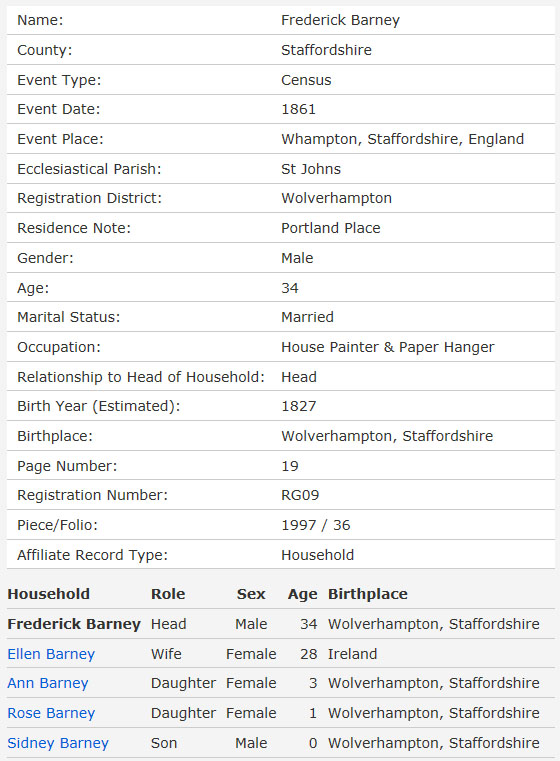
Source:
https://www.familysearch.org/ark:/61903/1:1:M7Z4-VMM
Contemporary newspaper announcements reveal that Edwin
had a business partnership with a William Robinson in Market Street,
Wolverhampton and were trading as 'Barney and Robinson'.
Edwin, himself, was
adjudged by Staffordshire County Court to be bankrupt on September 17, 1866.
Announcing
first meeting of creditors to take place on October 12, 1866:
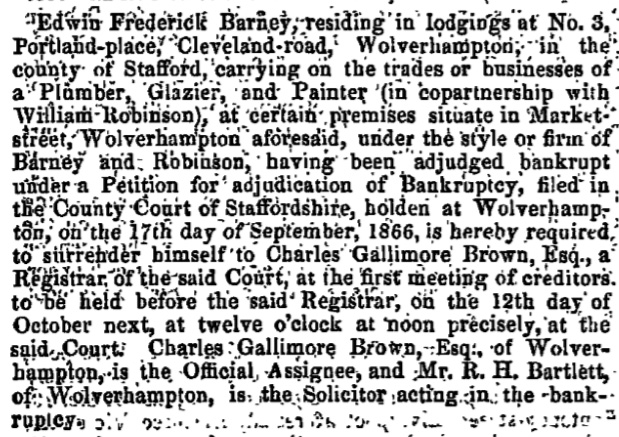
Source: The London Gazette - Sept 28
1866 - Pg. 5275
Announcing public meeting for Edwin to 'pass his
last examination' and make application for his Discharge to take place on
November 30, 1866:
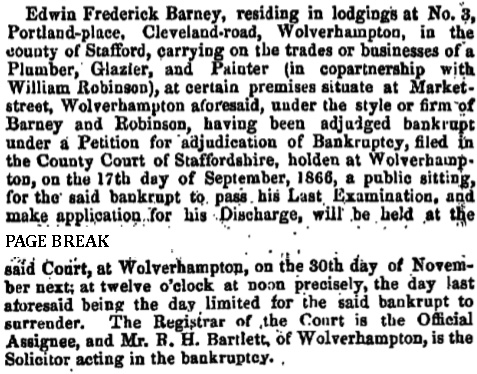
Source: The London Gazette - Oct 23
1866 - Pg. 5639-5640
Announcing Order of Discharge which was granted on August 6, 1867.
Note
that the year date given for adjudicated bankruptcy should read 1866, and not
1867. (Compare with announcements above.)
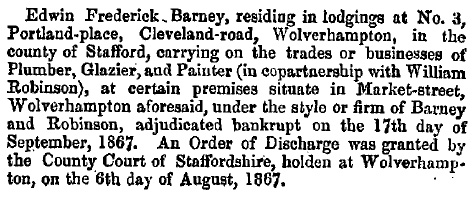
Source: The London Gazette, August 20
1867 - Pg. 4657
The 1871 Census -
Edwin yet to be found
The next documented evidence of Edwin's life-story, is
a passenger list related to the voyage of a ship, the 'Eskdale' which arrived in
Melbourne, Australia on April 4, 1873. Edwin's name appears - but not Ellen's,
nor any of the children. He travelled alone - apparently abandoning his family.
Contemporary Australian newspaper announcements confirm that he lived out his
life in Goodwood, Adelaide. South Australia.
_small.jpg)
Source:
https://www.familysearch.org/ark:/61903/1:1:QGPN-57FQ
(Note that Edwin's
middle initial 'F' has been transcribed incorrectly as 'K'. One has only to
compare handwriting elsewhere in the original document scan to see that this is
'our' Edwin. (i.e. 'Samuel Falkner' three rows below Edwin, and
'Farmer' - Edwin's stated profession on this occasion)
His age, 45 years, on the day of departure is consistent with his known
Baptism date of March 26, 1827.
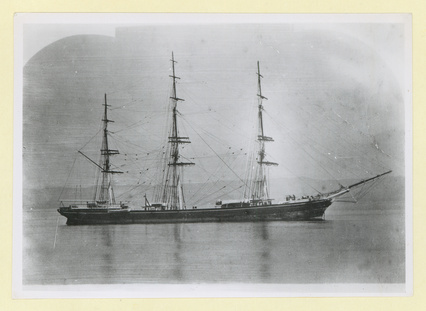
The 'Eskdale' in an unidentified port
Source:
https://collections.slsa.sa.gov.au/resource/PRG+1373/9/47
The first reference to Edwin in Australia after his arrival in 1873 is a notice placed by Edwin, in Adelaide's Express and Telegraph Newspaper (page 36), dated August 7, 1879.
%20thursday%207th%20august%201879%20page.36.jpg)
In the
United Kingdom 1881 census, Ellen appears as head of her household and a 'W'
indicates she told the enumerator that she was a widow. Either she'd believed
that Edwin was dead, or most likely - since no death registration exists, she
concealed the truth - perhaps also from her children.
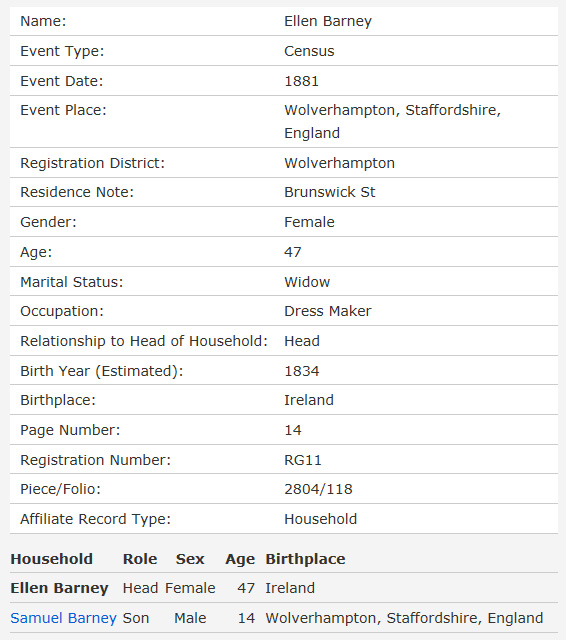
Source:
https://www.familysearch.org/ark:/61903/1:1:Q27F-SG92
A news clipping from Adelaide's Express and Telegraph (page 2) dated June 14, 1881. Clearly a reply from the Editor relating to an unidentified event or incident.
%20tues%2014%20june%201881%20page.2-.jpg)
Edwin placed a notice to let his house in Adelaide's South Australian Register (dated Tuesday June 17, 1884 - on page 8). It is not known if he was the owner of the property or if he was intending to sub-let (i.e. 'Mrs Fisher' being the property landlord).
%20tuesday%2017%20june%201884%20page.8.jpg)
A notice of dissolution from Adelaide's Evening Journal
(page 1), dated Monday, March 30, 1885.
Edwin had had a painting and
decorating business partnership trading as 'Barney & Page'.
%20%201885%20(monday%20march%2030)%20%20page.1.jpg)
The following 1889 newspaper notices indicate that Edwin was active in the setting up of business and the manufacture of paint - made from 'yellow ochre' discovered during mining excavations for silver at Mount Rhine.
%20monday%208th%20July%201889%20page.3.jpg)
Adelaide's Express and Telegraph (page 3) dated
Monday, July 8, 1889.
Advertisements for Edwin's
paint
%20tuesday%2030%20July%201889%20page.2.jpg)
The South Australian Register (page 2) dated Tuesday,
July 30, 1889.
%20tues%206%20aug%201889%20page.2%20(advertising).jpg)
Adelaide's Evening Journal (page 2) dated Tuesday,
August 6, 1889.
Edwin appears to have been very influential (either as
an adviser, or actually in business with) the Mount Rhine Silver Mining Company.
It is interesting to note that even though they were mining for silver, Edwin's
influence on the Directors of the Company was such that they were advocating to
the shareholders that the substantial quantity of 'yellow ochre' would be reward
enough for their investments in the Company, even if no silver were found.
%20wednesday%207th%20august%201889%20page.4.jpg)
Adelaide's Express and Telegraph (page 4) dated
Wednesday, August 7, 1889.
Presumably, Edwin's association with the Mount Rhine Silver Mining Company was not the great success that he was expecting as on June 16, 1892 he went into partnership with William G. Johnston, setting up business as painters and decorators.
%20friday%2017th%20june%201892%20page.1.jpg)
Adelaide's Express and Telegraph (page 1) dated
Friday, June 17, 1892.
Edwin's business partnership may have lasted only a short time because on November 13, 1893, he was auctioning off all of his stock, tools and materials - and 'giving up business'.
%20saturday%2011%20november%201893%20page.8.jpg)
The South Australian Register (page 8) dated Saturday,
November 11, 1893.
1894 finds Edwin on the committee of the 'Goodwood Institute'; a recently expanded public hall which is still in use today. http://new.goodwoodinstitute.com.au/
%20wed%2015%20august%201894%20page.4-.jpg)
Adelaide's Evening Journal (page 4) dated Wednesday,
August 15, 1894.
On Monday, December 29, 1903, while Edwin was holidaying in Glenelg, his house in Goodwood Road was burgled. Newspaper reports are displayed below - and note that in the third item, mention is made of 'Mr & Mrs Barney' - the first evidence we have of Edwin living with a woman as 'man & wife'. No marriage record has been found.
%20tuesday%2030th%20dec%201902%20page.1.jpg)
Adelaide's Express and Telegraph (page 1) dated
Tuesday, December 30, 1902.
%20tues%2030%20Dec%201902%20page.1.jpg)
Adelaide's Evening Journal (page 1) dated Tuesday,
December 30, 1902.
%20thurs%208%20Jan%201903%20page.6.jpg)
The Advertiser (Adelaide) (page 6) dated Thursday,
January 8, 1903.
In 1904, Edwin put his house up for sale.
%20tues%201%20Nov%201904%20page.3.jpg)
The Advertiser (Adelaide) (page 6) dated Tuesday,
November 1, 1904.
Subsequently he lived in Victoria Street, Goodwood.
On May 30, 1909, Edwin's legal wife Ellen, died aged 76*,
in Islington, London.
*based on her Christening
date - January 27, 1833

Note that in column 5 it states she was the widow of (Edwin) Frederick Barney. This would suggest that neither she nor any of her family knew that Edwin was alive and well in Australia - but see alternative theory in "'BARNEY' or 'BARNETT'? section at the bottom of this page.
Almost a year to the day, Edwin died on May 31, 1910.
%20tuesday%2031%20May1910%20page.1.jpg)
Adelaide's Express and Telegraph (page 1) dated
Tuesday, May 31, 1910.
Edwin is buried at West Terrace Cemetery, Adelaide, Adelaide City, South Australia; Plot: Road 1 Nth, Path 15, Site E29
![]()
![]()
Click thumbnail images* to enlarge.
*Source:
https://www.findagrave.com/memorial/156431183
Edwin's partner - here identified as Eleanor Brice Barney, lived on until 1932. Her age at death, 82, confirms that she was born 1849/1850; approx. 22 years younger than Edwin. Note that "Police enquiries...failed to locate any relatives of the woman in South Australia". It therefore seems unlikely that Edwin fathered any children in Australia.
%20friday%20dec%202nd%201932%20(pg.1)%20.jpg)
%20Mon%205%20Dec%201932%20page.10.jpg)
Eleanor is buried in the same grave as Edwin. (Details above)
'BARNEY' or 'BARNETT'?
My own grandmother (a granddaughter of Sydney Frederick Barney) was born a 'Barnett' and as a child I met and knew my great grandmother as 'Nanny Barnett'. Likewise, my mother met and knew her great grandmother (the wife of Sydney Frederick Barney) as 'Granny Barnett', and 'Barnett' is the family name I and others in my family have known throughout our lives. It was therefore a revelation to discover - only recently in December 2018 - that 'Barney' was the original family name.
Based on available documented evidence, Sydney Frederick
Barney, appears to have been the first of the Barney family to use the 'Barnett'
alias when he married Maria Eliza Claxton Smith in 1880. All of their children
inherited the 'Barnett' name, though Sydney's daughter Caroline Ellen used the
original name 'Barney' when she married in 1912, and Sydney's own death
registration* uses the name 'Barney' in 1921.
*An
inserted note reads "otherwise Barnett".
No documented explanation
has been found for the name change, and we can only theorise possible reasons
based on what we already know about Sydney and his ancestry. Some of my ideas
are detailed below.
Discussing Sydney's son 'Sidney' (b.1881) with my
aunt 'Sallie' some years ago, I was told that the family "sometimes used the
name Barney", and curiously "..they may have been in trouble with the
law."
Changing one's name to hide identity is certainly consistant with
illegal or fraudulant practises, but I've found no documented evidence to
support it in this family's case.
Note that Sallie (like me) always believed
that 'Barnett' was the family name, and she was suggesting that 'Barney' was the
alias.
We know that Sydney's son, Sidney (b.1881), was involved in the business of money-lending, and it is possible that his father was too. They may have operated covertly, and hiding identity would be consistent with not declaring taxable income. But Sidney (b.1881) was born a Barnett, so for him the name wasn't even an alias.
Since the first documented use of the 'Barnett' name is in Sydney's marriage certificate (1880), I can't help wondering whether the actions of his father (Edwin) may have had something to do with the name change. After all, Edwin had recently (1873) abandoned his wife and family, making a new life for himself in Australia. The distress and sadness that must surely have befallen his mother may well have caused Sydney to disassociate himself and his new young wife from his 'tarnished family name', as he may have seen it. It should also be noted that Sydney had migrated to London from Wolverhampton by the time of his marriage - this perhaps suggesting a desire for a new name, ..and a new life.
Though I've used the word 'abandoned' in the context of
Edwin's leaving England for a new life in Australia, we don't actually know
why he went. There is no indication in the
'Eskdale' ship's passenger list that Edwin was travelling with a mistress. Nor
did he attempt to hide his name. Even so, the fact that he never returned to
England suggests that he was running away from something that ultimately
overrided any desire (he must surely have had) to see his children again. After
arriving in Australia in 1873, he lived a further 37 years.
While there
may be a presumption that Edwin brought shame on the family, we have to also
consider the possibility that Edwin's family didn't even know he was alive and
well in Australia. If this were true, Ellen and her family would have mourned
the loss of Edwin. There is no evidence that any of Edwin's children ever sailed
to Australia to visit him, and Edwin's wife Ellen identified herself as a
'widow' in the censuses of 1881, 1891. However, Sydney's marriage certificate of
1880 identifies Edwin as his father (albeit with the 'Barnett'
alias), but with no indication that he was 'deceased' - as one would expect if
the groom believed his father was indeed deceased. But without a death
certificate, it may just not have been permissable to 'presume' a person's death
on a legal document.
It should be said that if the family didn't know that
Edwin was alive, his disappearance is unlikely to have been a factor in the
decision of Sydney Frederick Barney to change his family name.
My personal belief is that
the family must have known he was alive. If Edwin really needed to disappear
(e.g. he had committed a heinous crime and was a wanted man) he wouldn't have
used his real identity when boarding the ship, or when he was living in
Australia. He did both, openly. I therefore see no reason why he wouldn't have
at least written a letter to his family - to inform them that he was alive and
well, or even had a conversation with his family, or someone in the family,
before he left.
Edwin's son Sydney Frederick Barney was the only
among his siblings to change his name to Barnett, and the Barnett name was only
used by his descendents.
Note: "Contrary to popular belief, it
has always been possible to change your name without having to register the
change with any official body. It is still perfectly legal for anyone over the
age of 16 to start using a new name at any time, as long as they are not doing
so for a fraudulent or illegal reason."
Source:
http://www.nationalarchives.gov.uk/help-with-your-research/research-guides/changes-of-name/